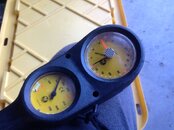caruso
Banned
This question has been asked and answered countless times on this forum, and yours is probably not the first poll. What's the point of a poll anyway? Are you going to do what most people do? Hopefully not. Do what works for you even if it's only 15% of the diving population or whatever.
It all comes down to whether or not you're ok with rising losing one or more dives and up to a weeks worth of Nitrogen loading data as well as logbook data in exchange for not spending the money on a replacement computer which can be found for under $100 used on Ebay. To me it makes no sense to hold onto the money which is about the same as a 2 tank dive trip in most places.
It all comes down to whether or not you're ok with rising losing one or more dives and up to a weeks worth of Nitrogen loading data as well as logbook data in exchange for not spending the money on a replacement computer which can be found for under $100 used on Ebay. To me it makes no sense to hold onto the money which is about the same as a 2 tank dive trip in most places.





